Abstract
Intraluminal pressure was measured in the isolated, fluid-filled trachea of the guinea pig, with autonomic innervation on the right side intact. Increases or decreases in intraluminal pressure reflected excitatory or inhibitory responses respectively, in the tracheal smooth muscle. Stimulation of the cervical vagus nerve evoked a cholinergic excitatory response. After cholinergic blockade with atropine, a non-adrenergic, non-cholinergic inhibitory response was obtained. Stimulation of the cervical sympathetic trunk, or stellate ganglion, evoked beta-adrenergic inhibitory responses. In the presence of propranolol, sympathetic stimulation evoked alpha-adrenergic excitatory responses which were of low amplitude (less than or equal to 5% of cholinergic excitatory responses). In the presence of phentolamine but not prazosin, beta-adrenergic inhibitory responses were potentiated. Neostigmine potentiated responses to vagal stimulation, increasing the amplitude and duration of response. At higher concentrations neostigmine (i) raised intraluminal pressure, a response blocked by atropine, and (ii) attenuated sympathetic inhibitory responses, an effect largely blocked by atropine. Histamine increased intraluminal pressure and this response was attenuated by atropine. In the presence of histamine, vagal excitatory responses were attenuated. Sympathetic inhibitory responses at low frequencies of stimulation (up to 10 Hz) were inhibited by histamine. 5-Hydroxytryptamine (5-HT) increased intraluminal pressure also, an effect partially blocked by atropine. 5-HT had no effect on vagal excitatory responses. Like histamine, 5-HT attenuated sympathetic inhibitory responses at lower frequencies of stimulation.
Full text
PDF
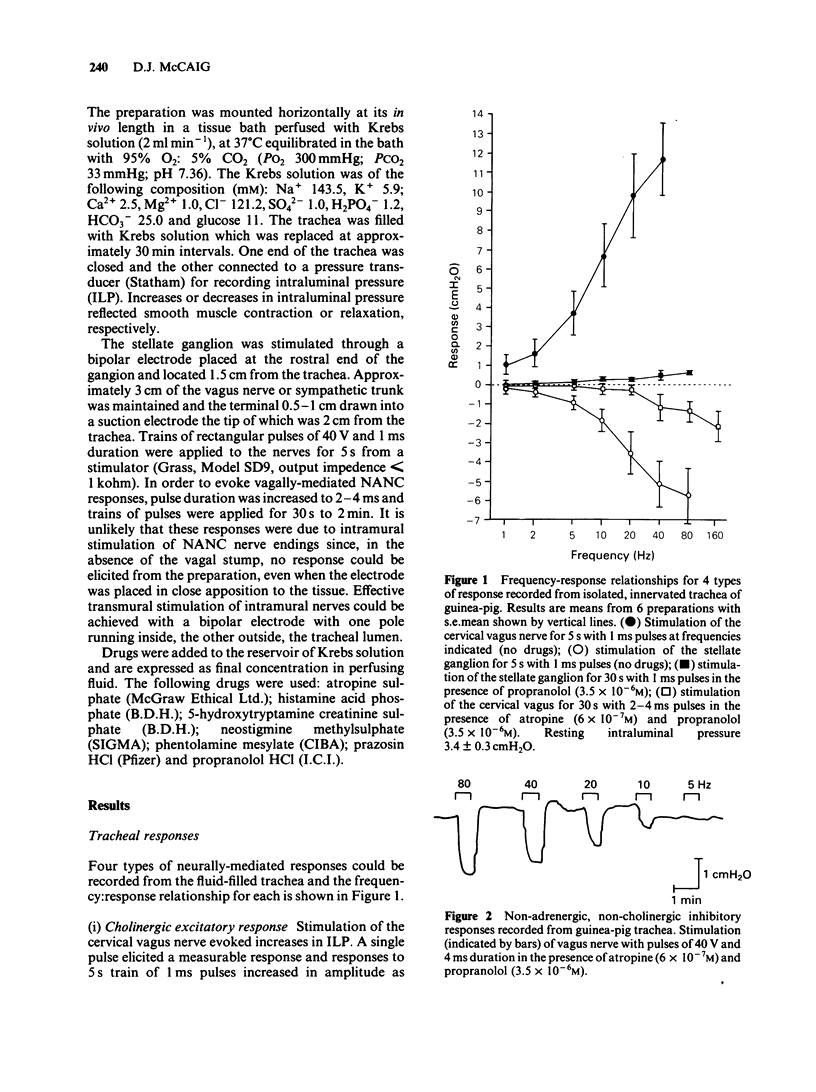

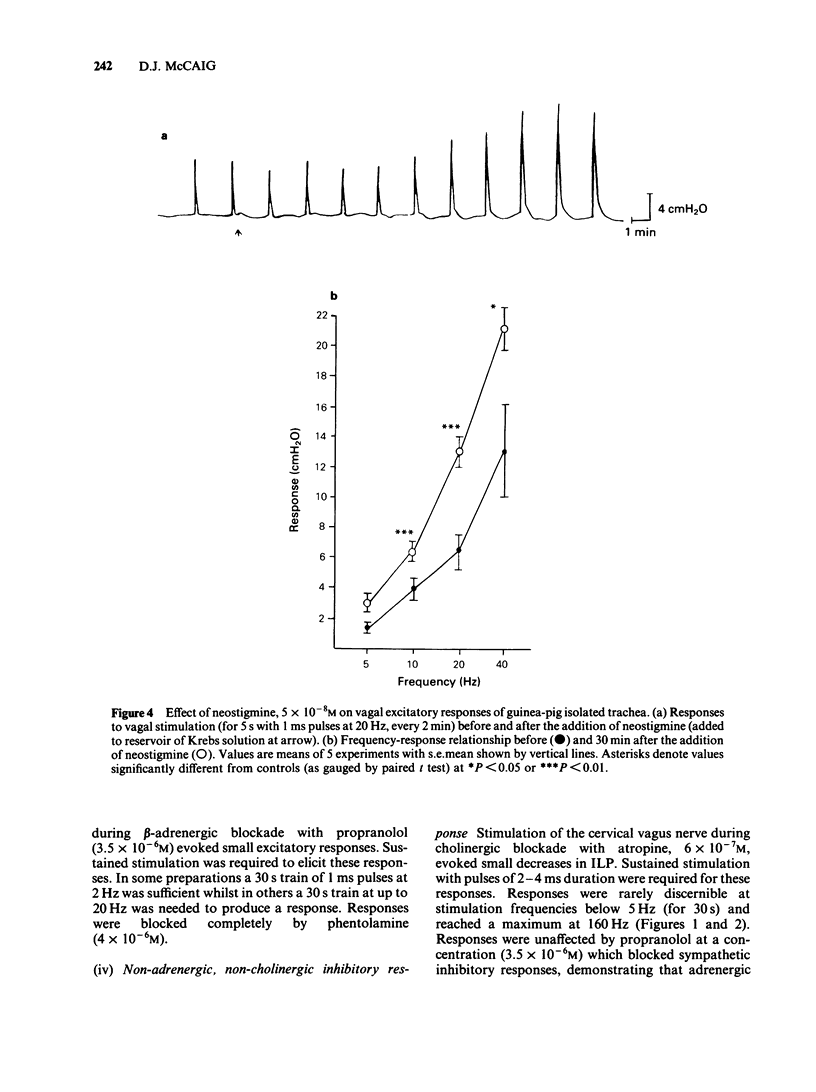
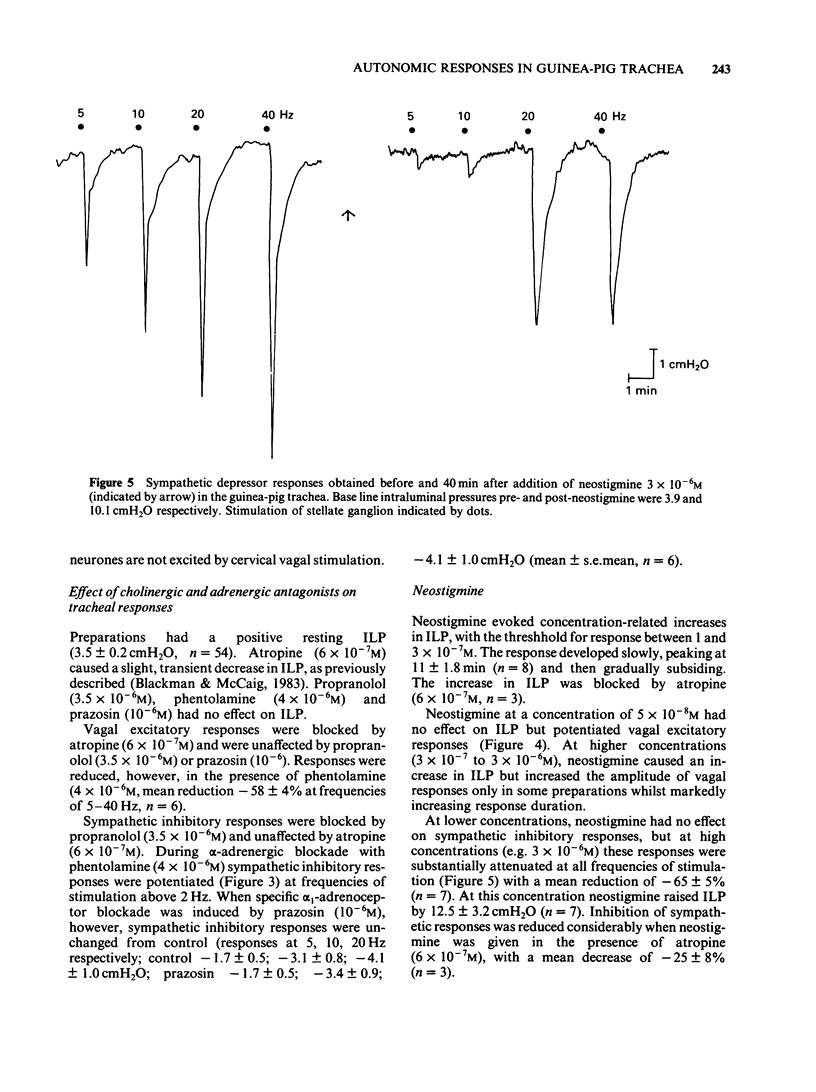

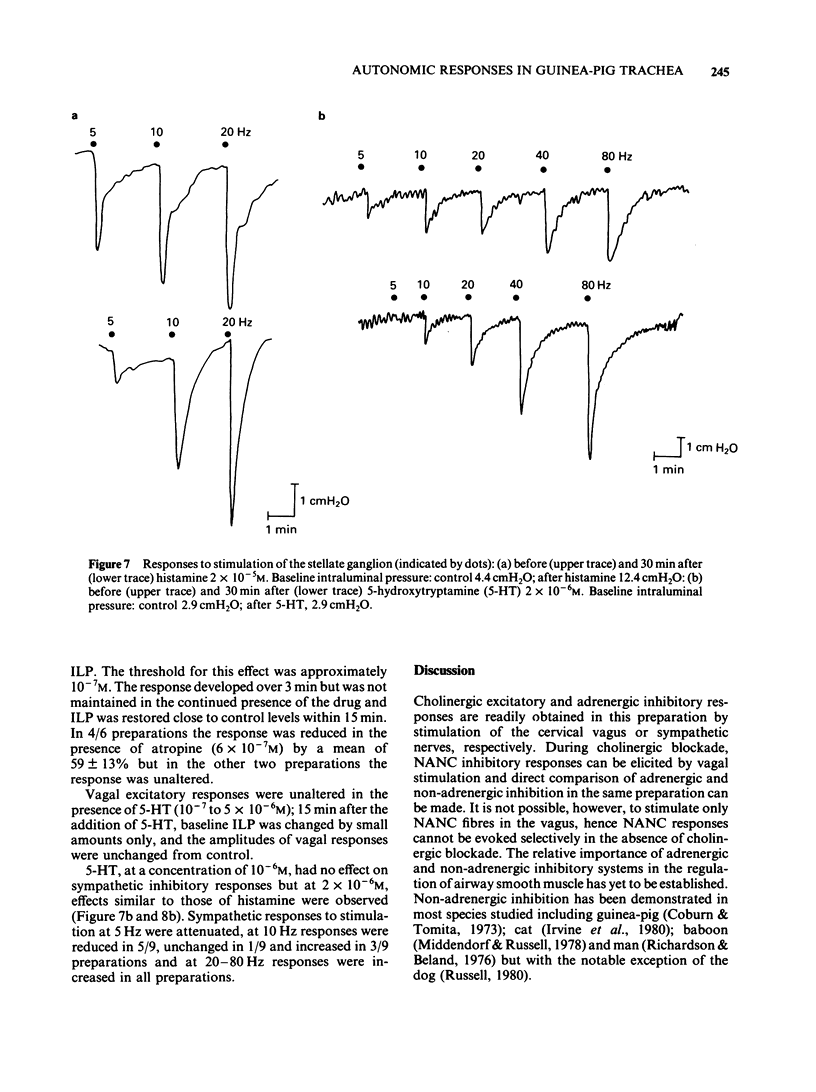
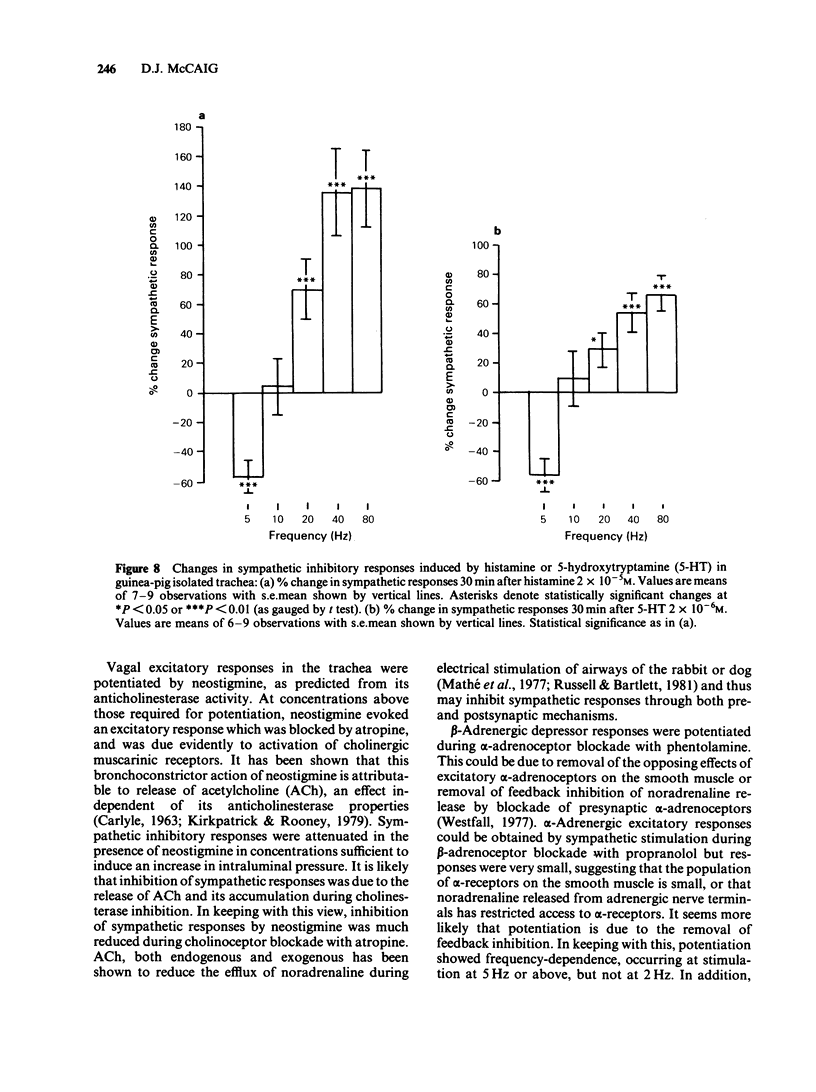

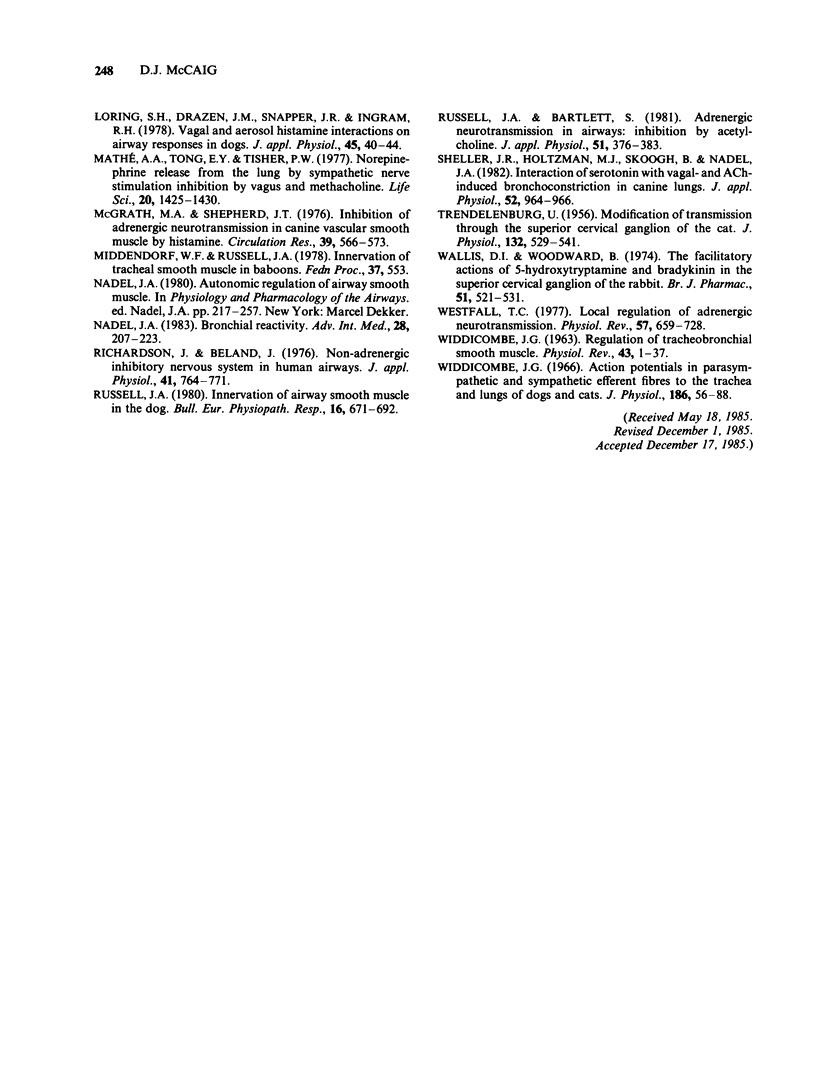
Selected References
These references are in PubMed. This may not be the complete list of references from this article.
- Benson M. K., Graf P. D. Bronchial reactivity: interaction between vagal stimulation and inhaled histamine. J Appl Physiol Respir Environ Exerc Physiol. 1977 Oct;43(4):643–647. doi: 10.1152/jappl.1977.43.4.643. [DOI] [PubMed] [Google Scholar]
- Blackman J. G., McCaig D. J. Studies on an isolated innervated preparation of guinea-pig trachea. Br J Pharmacol. 1983 Dec;80(4):703–710. doi: 10.1111/j.1476-5381.1983.tb10061.x. [DOI] [PMC free article] [PubMed] [Google Scholar]
- CARLYLE R. F. THE MODE OF ACTION OF NEOSTIGMINE AND PHYSOSTIGMINE ON THE GUINEA-PIG TRACHEALIS MUSCLE. Br J Pharmacol Chemother. 1963 Aug;21:137–149. doi: 10.1111/j.1476-5381.1963.tb01509.x. [DOI] [PMC free article] [PubMed] [Google Scholar]
- Chesrown S. E., Venugopalan C. S., Gold W. M., Drazen J. M. In vivo demonstration of nonadrenergic inhibitory innervation of the guinea pig trachea. J Clin Invest. 1980 Feb;65(2):314–320. doi: 10.1172/JCI109674. [DOI] [PMC free article] [PubMed] [Google Scholar]
- Coburn R. F., Tomita T. Evidence for nonadrenergic inhibitory nerves in the guinea pig trachealis muscle. Am J Physiol. 1973 May;224(5):1072–1080. doi: 10.1152/ajplegacy.1973.224.5.1072. [DOI] [PubMed] [Google Scholar]
- Hahn H. L., Wilson A. G., Graf P. D., Fischer S. P., Nadel J. A. Interaction between serotonin and efferent vagus nerves in dog lungs. J Appl Physiol Respir Environ Exerc Physiol. 1978 Feb;44(2):144–149. doi: 10.1152/jappl.1978.44.2.144. [DOI] [PubMed] [Google Scholar]
- Irvin C. G., Boileau R., Tremblay J., Martin R. R., Macklem P. T. Bronchodilatation: noncholinergic, nonadrenergic mediation demonstrated in vivo in the cat. Science. 1980 Feb 15;207(4432):791–792. doi: 10.1126/science.7352292. [DOI] [PubMed] [Google Scholar]
- Kikuchi Y., Okayama H., Okayama M., Sasaki H., Takishima T. Interaction between histamine and vagal stimulation on tracheal smooth muscle in dogs. J Appl Physiol Respir Environ Exerc Physiol. 1984 Mar;56(3):590–595. doi: 10.1152/jappl.1984.56.3.590. [DOI] [PubMed] [Google Scholar]
- Kirkpatrick C. T., Rooney P. J. The contracture produced in tracheal smooth muscle by anticholinesterases [proceedings]. Br J Pharmacol. 1979 Nov;67(3):464P–465P. [PMC free article] [PubMed] [Google Scholar]
- Loring S. H., Drazen J. M., Snapper J. R., Ingram R. H., Jr Vagal and aerosol histamine interactions on airway responses in dogs. J Appl Physiol Respir Environ Exerc Physiol. 1978 Jul;45(1):40–44. doi: 10.1152/jappl.1978.45.1.40. [DOI] [PubMed] [Google Scholar]
- Mathé A. A., Tong E. Y., Tisher P. W. Norepinephrine release from the lung by sympathetic nerve stimulation inhibition by vagus and methacholine. Life Sci. 1977 Apr 15;20(8):1425–1430. doi: 10.1016/0024-3205(77)90371-x. [DOI] [PubMed] [Google Scholar]
- McGrath M. A., Shepherd J. T. Inhibition of adrenergic neurotransmission in canine vascular smooth muscle by histamine: mediation by H2-receptors. Circ Res. 1976 Oct;39(4):566–573. doi: 10.1161/01.res.39.4.566. [DOI] [PubMed] [Google Scholar]
- Nadel J. A. Bronchial reactivity. Adv Intern Med. 1983;28:207–223. [PubMed] [Google Scholar]
- Richardson J., Béland J. Nonadrenergic inhibitory nervous system in human airways. J Appl Physiol. 1976 Nov;41(5 Pt 1):764–771. doi: 10.1152/jappl.1976.41.5.764. [DOI] [PubMed] [Google Scholar]
- Russell J. A., Bartlett S. Adrenergic neurotransmission in airways: inhibition by acetylcholine. J Appl Physiol Respir Environ Exerc Physiol. 1981 Aug;51(2):376–383. doi: 10.1152/jappl.1981.51.2.376. [DOI] [PubMed] [Google Scholar]
- Russell J. A. Innervation of airway smooth muscle in the dog. Bull Eur Physiopathol Respir. 1980 Sep-Oct;16(5):671–692. [PubMed] [Google Scholar]
- Sheller J. R., Holtzman M. J., Skoogh B. E., Nadel J. A. Interaction of serotonin with vagal- and ACh-induced bronchoconstriction in canine lungs. J Appl Physiol Respir Environ Exerc Physiol. 1982 Apr;52(4):964–966. doi: 10.1152/jappl.1982.52.4.964. [DOI] [PubMed] [Google Scholar]
- TRENDELENBURG U. Modification of transmission through the superior cervical ganglion of the cat. J Physiol. 1956 Jun 28;132(3):529–541. doi: 10.1113/jphysiol.1956.sp005546. [DOI] [PMC free article] [PubMed] [Google Scholar]
- WIDDICOMBE J. G. Regulation of tracheobronchial smooth muscle. Physiol Rev. 1963 Jan;43:1–37. doi: 10.1152/physrev.1963.43.1.1. [DOI] [PubMed] [Google Scholar]
- Wallis D. I., Woodward B. The facilitatory actions of 5-hydroxytryptamine and bradykinin in the superior cervical ganglion of the rabbit. Br J Pharmacol. 1974 Aug;51(4):521–531. doi: 10.1111/j.1476-5381.1974.tb09670.x. [DOI] [PMC free article] [PubMed] [Google Scholar]
- Westfall T. C. Local regulation of adrenergic neurotransmission. Physiol Rev. 1977 Oct;57(4):659–728. doi: 10.1152/physrev.1977.57.4.659. [DOI] [PubMed] [Google Scholar]
- Widdicombe J. G. Action potentials in parasympathetic and sympathetic efferent fibres to the trachea and lungs of dogs and cats. J Physiol. 1966 Sep;186(1):56–88. doi: 10.1113/jphysiol.1966.sp008020. [DOI] [PMC free article] [PubMed] [Google Scholar]


